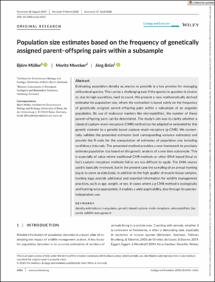Müller, Björn; Mercker, Moritz; Brün, Jörg: Population size estimates based on the frequency of genetically assigned parent–offspring pairs within a subsample. In: Ecology and evolution. 2020, vol. 10, iss. 13, 6356-6363.
Online-Ausgabe in bonndoc: https://hdl.handle.net/20.500.11811/10548
Online-Ausgabe in bonndoc: https://hdl.handle.net/20.500.11811/10548
@article{handle:20.500.11811/10548,
author = {{Björn Müller} and {Moritz Mercker} and {Jörg Brün}},
title = {Population size estimates based on the frequency of genetically assigned parent–offspring pairs within a subsample},
publisher = {John Wiley & Sons},
year = 2020,
month = jul,
journal = {Ecology and evolution},
volume = 2020, vol. 10,
number = iss. 13,
pages = 6356--6363,
note = {Estimating population density as precise as possible is a key premise for managing wild animal species. This can be a challenging task if the species in question is elusive or, due to high quantities, hard to count. We present a new, mathematically derived estimator for population size, where the estimation is based solely on the frequency of genetically assigned parent–offspring pairs within a subsample of an ungulate population. By use of molecular markers like microsatellites, the number of these parent–offspring pairs can be determined. The study's aim was to clarify whether a classical capture–mark–recapture (CMR) method can be adapted or extended by this genetic element to a genetic-based capture–mark–recapture (g-CMR). We numerically validate the presented estimator (and corresponding variance estimates) and provide the R-code for the computation of estimates of population size including confidence intervals. The presented method provides a new framework to precisely estimate population size based on the genetic analysis of a one-time subsample. This is especially of value where traditional CMR methods or other DNA-based (fecal or hair) capture–recapture methods fail or are too difficult to apply. The DNA source used is basically irrelevant, but in the present case the sampling of an annual hunting bag is to serve as data basis. In addition to the high quality of muscle tissue samples, hunting bags provide additional and essential information for wildlife management practices, such as age, weight, or sex. In cases where a g-CMR method is ecologically and hunting-wise appropriate, it enables a wide applicability, also through its species-independent use.},
url = {https://hdl.handle.net/20.500.11811/10548}
}
author = {{Björn Müller} and {Moritz Mercker} and {Jörg Brün}},
title = {Population size estimates based on the frequency of genetically assigned parent–offspring pairs within a subsample},
publisher = {John Wiley & Sons},
year = 2020,
month = jul,
journal = {Ecology and evolution},
volume = 2020, vol. 10,
number = iss. 13,
pages = 6356--6363,
note = {Estimating population density as precise as possible is a key premise for managing wild animal species. This can be a challenging task if the species in question is elusive or, due to high quantities, hard to count. We present a new, mathematically derived estimator for population size, where the estimation is based solely on the frequency of genetically assigned parent–offspring pairs within a subsample of an ungulate population. By use of molecular markers like microsatellites, the number of these parent–offspring pairs can be determined. The study's aim was to clarify whether a classical capture–mark–recapture (CMR) method can be adapted or extended by this genetic element to a genetic-based capture–mark–recapture (g-CMR). We numerically validate the presented estimator (and corresponding variance estimates) and provide the R-code for the computation of estimates of population size including confidence intervals. The presented method provides a new framework to precisely estimate population size based on the genetic analysis of a one-time subsample. This is especially of value where traditional CMR methods or other DNA-based (fecal or hair) capture–recapture methods fail or are too difficult to apply. The DNA source used is basically irrelevant, but in the present case the sampling of an annual hunting bag is to serve as data basis. In addition to the high quality of muscle tissue samples, hunting bags provide additional and essential information for wildlife management practices, such as age, weight, or sex. In cases where a g-CMR method is ecologically and hunting-wise appropriate, it enables a wide applicability, also through its species-independent use.},
url = {https://hdl.handle.net/20.500.11811/10548}
}






